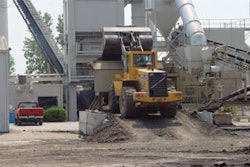The cost of oil is staggeringly high, the cost of hot mix has spiked accordingly, and environmental and health regulations continue to make an impact in the market.
Changes in the paving industry are underway, so Pavement Maintenance & Reconstruction turned to the National Asphalt Pavement Association's Mike Acott, president, to gain some insights into what paving contractors might be facing in the future. NAPA is an organization of hot mix asphalt producers and high-volume paving contractors - if you buy hot mix you probably buy it from a NAPA member - so there's probably no better place to turn to ask someone to gaze into the crystal ball.
And Acott says that much of what paving contractors are going to be dealing with in the future is occurring at some level or other right now.
Recycled asphalt pavement
One of the biggest current trends is the use of recycled asphalt pavement (RAP) in hot mix asphalt. Acott estimates that plants across the country currently use an average of 12½% to 15% RAP in their mixes. But Acott says that average includes a number of geographic areas that use a limited amount of RAP or certain mixes that use no RAP at all. NAPA's goal is to remove those barriers.
"We think there's a lot of opportunity to raise that number quite significantly and we've had plenty of experience in running high-RAP mixes," he says. He says the cost of raw materials has made RAP more acceptable.
Acott says projects throughout the country have contained 35% RAP and more, and it's not unusual to see mixes that contain more than 20% RAP content. In the future he wouldn't be surprised to see RAP use increasing to a 25% to 35% average.
"The laydown contractors shouldn't see or feel any difference as RAP content increases," Acott says. "It should handle just as easy as a regular mix."
Warm mix asphalt
Warm mix asphalt might make the biggest impact on paving contractors of the future. Warm mix is in a transition from test sections to full-scale projects and expectations and hopes for this new technology are high.
"I don't think we've touched on all the possibilities with warm mix, particularly with laydown commercial pavers," Acott says. "But all our experience with warm mix is very, very positive, and we see no reason to believe that warm mix will perform any worse than hot mix asphalt."
He says warm mix is new enough that all its benefits for the laydown paving industry have yet to be fully explored, but among the improvements that can be expected are longer haul times for trucking mix from the plant, longer storage times, and extending the paving season.
"We also think there's a potential for a boost in pavement quality," Acott says. "At this point it appears to us that we're getting more consistent results in compaction and very good longitudinal joints."
He adds that the workers themselves will see a benefit too. "The net effect for pavers is obviously working conditions are going to significantly improve in terms of heat, fumes, and odor," Acott says. "That's a benefit we are going to see."
He says the industry will place close to 1 million tons of warm mix in 2008, adding that "some pretty substantial projects are already in the pipeline."
"Of all the things in the industry the pavers should be watching, warm mix is it," Acott says. He says that at least 100 hot mix plants are making adjustments to produce and promote it for next season, and there's no reason to think warm mix won't find its way soon to commercial paving jobs.
Porous asphalt pavement
Created as an alternative to water management in developments, porous asphalt pavement is already becoming more common for parking lot pavement. "We think the paving industry is so well placed on porous asphalt pavement," Acott says. "Open-graded mixes are our bread and butter. We do them, and we do them well."
He says the paving industry not only has a lot of experience with porous asphalt pavement, it has a lot of experience with porous asphalt pavement in various climates.
He says that NAPA anticipates so much interest in porous asphalt pavements, and there has been so much development in recent years, that it is updating and reprinting its design guides on porous asphalt pavement.



















